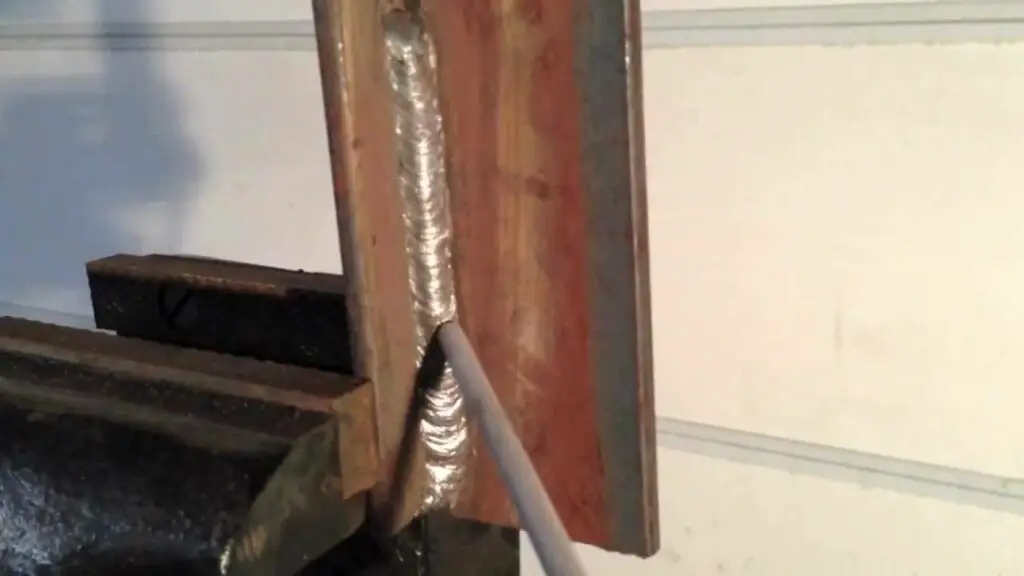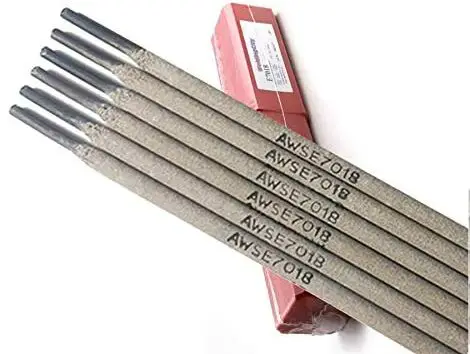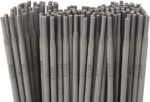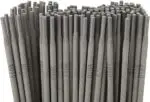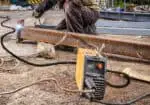Whether you call it SMAW, Vertical Shielded Metal Arc Welding, or Stick Welding, this welding method is always in demand.
Numerous industries that range from building construction, shipyards, pipe fitting, power plants, or the oil and gas industry all need Stick welding to guarantee production.
The principal reason stick welding is needed is due to the fact that many large metal pieces or metal sections that require welding cannot be moved or maneuvered for horizontal welding positions.
Stick welding is also preferred over other types of welding because the pieces needing to be welded are exceptionally thick. Stick welding accessories like exceptionally long leads permit welding applications that other welding equipment would not permit.
Finding the correct rod or electrode is fundamental particularly for vertical welding. We asked several professional shipyard welders to find us the best rod for vertical welding. This is what we discovered.
We’ve chosen a favorite rod for various applications so keep reading!
| Rod | Tensile Strength | AC or DC | Penetration | Diameter |
|---|---|---|---|---|
| Forney 31610 E6010 Electrode | 60,000 psi | DC | Deep | 1/8-inch |
| Hobart 6011 Stick Electrode 770460 | 60,000 psi | AC or DCEP | Deep | 1/8-inch |
| Forney E6013 Welding Electrode 30305 | 60,000 psi | AC, DC | Shallow | 3/32-inch |
| Forney E7018 Welding Electrode 30705 | 70,000 psi | AC, DC+ | For metals at risk of cracking | 3/32-inch |
Gravity and the Rod in Vertical Welding
The 7018 Rod
Dealing with gravity is the principal challenge that welders face when performing vertical up welding. This will be true in any welding position that is 45° or steeper.
Vertical rods that have an AWS 7018 classification are generally preferred because they contain low quantities of iron.
This means that molten metal will create a weld puddle that will freeze rapidly meaning that it is less likely to drip while liquid.
The 6010 Rod
An AWS 6010 is also employed for the same reasons. The difference will lie in that the 7018 rods will permit a weaving pattern that is quicker.
A 6010 rod uses the whipping technique or stacking method. With this method, the rod will move in and out of your welding puddle.
The 6010 vertical rod works well even if surface conditions are less than ideal, but you will need a lot more time and a better skill level to weld.
A 7018 rod will be more manageable. One rod not to choose is the 7024. This rod will drip down the work as you weld.
Vertical Welding Positions
Vertical up welding is the slowest type of stick welding because this position fights gravity throughout the operation.
A slower speed will allow you better penetration than when using vertical down, so it is the go-to technique for thick metal pieces, those thicker than sheet metal.
The main difficulty is in preventing the spilling of the puddle out of the weld. When welding thick metals vertical uphill welding is preferred.
Vertical down welding functions well on sheet metal because less penetration is required. The more rapid speed makes for cooler temperatures, and this will impede burn-through.
Bricklaying
Vertical up welding is often compared to a bricklayer’s work because as in laying bricks, you create the weld beginning at the bottom and work upwards.
A small weld section is created as a base for the next weld section. The lower weld bead is called the shelf.
Every shelf should measure 1.5 to 2 times the electrode’s diameter. This means that a 1/8-inch vertical rod will have to create a puddle that measures 1/6 to ¼-inch and that freezes quickly enough to act as the base for the next weld.
When using a 7018 rod you will use a weaving technique, by zigzagging back and forth.
The use of a 6010 electrode means using a stacking technique. In this case, each weld will create a shelf for the next one, in the end stacking up like coins or poker chips. Here, too, each shelf should measure 1.5 to 2 times the electrode’s diameter.
Power
Since the puddle in vertical welding needs to freeze rapidly in its position, low amperage is employed to assure control, so use the welder’s lower amperage range.
Vertical Rod Classifications
When choosing the best rod for your vertical welding, you’ll have to consider parameters.
The welding rod must comply with the chemical composition and the mechanical properties of the base metal you are welding.
Joint geometry, cost, welding position, and the operating environment must all be factored in.
Thousands of welding electrodes exist, but the most commonly used are the
-
-
- E6010
- E6011
- E6012
- E6013
- E7018
- E7024
-
The American Welding Society has established standards that classify low-alloy steel rods and carbon steel rods for shielded arc welding of metals.
These are classified beginning with the letter “E”. Every digit that follows the letter E refers to a specific trait of the electrode.
When considering these numbers, the first two digits will refer to the tensile strength x 1000 PSI. An example of this is E60xx indicates a 60,000 psi tensile strength.
The third digit will refer to the welding position.
• A classification of Exx1x indicates flat, horizontal, overhead, or Vertical up
• A classification of Exx2x indicates horizontal and flat
• A classification of Exx3x indicates flat
• A classification of Exx4x indicates horizontal, flat, overhead, and vertical down
The final digit indicates the electrode’s usability.
| Exxx0 | cellulose, sodium | DC + | Deep penetrating |
| Exxx1 | Potassium, cellulose | AC or DC + | Deep penetrating |
| Exxx2 | Sodium, rutile | AC or DC – | Medium penetrating |
| Exxx3 | Potassium, rutile | AC and DC + or DC – | Light penetrating |
| Exxx4 | iron powder, rutile | AC and DC + or DC – | Medium penetrating |
| Exxx5 | Sodium, Low hydrogen | DC + | Medium penetrating |
| Exxx6 | Potassium, Low hydrogen | AC and DC + | Medium penetrating |
| Exxx7 | Iron Oxide, Iron powder | AC and DC – | Medium penetrating |
| Exxx8 | Iron powder, Low hydrogen | AC and DC + | Medium penetrating |
| Exxx9 | Potassium, Iron oxide, Rutile | AC and DC + or DC – | Medium penetrating |
The E6010 Electrode
This rod is characterized by molten metal that solidifies very quickly. It is known as a fast freeze electrode that is considered general purpose.
It functions well in all positions and works well in vertical up welding. It offers deep penetration welding.
The E6011 Electrode
Another fast freezing and general-purpose electrode, the E6011 welds in all positions and functions in vertical up welding. It is used principally for sheet metal. AC or DC power offers penetration that is deep.
The E6012 Electrode
A fast-freezing welding rod that is also fast-fill, known as a fill-freezing general purpose welding electrode. It works in all positions and offers a medium penetrating capability. Ideal for welding sheet metal and applications that are low current.
The E6013 Electrode
Another fill-freezing rod resembles the E6012 electrode but offers better weld quality and less spatter.
The E7018 Electrode
This is what is known as a low hydrogen rod produced for use with metal that is thick or is at risk for cracking.
This is an excellent rod for steel that needs exceptional strength. It does however require care when storing as it must be placed in a location with low humidity.
The E7024 Electrode
This is a fast-fill rod and is used above all for rapid welding as it deposits the molten metal quickly.
Our List of Favorite Best Rods for Vertical Welding
Best E6010 Welding Rod for Vertical Welding
1. Forney 31610 E6010 Electrode
- All position welding rod with digging arc, deep penetration on dirty, rusty and painted materials
- Ideal for joints requiring deep penetration such as square edge butt welds, good for vertical and overhead welding with light slag
- Minimal surface preparation required
Prices pulled from the Amazon Product Advertising API on:
Product prices and availability are accurate as of the date/time indicated and are subject to change. Any price and availability information displayed on [relevant Amazon Site(s), as applicable] at the time of purchase will apply to the purchase of this product.
An all-position electrode that offers deep penetration on painted, rusty, or dirty material. Ideal for joints and requires very little preparation of welding surfaces.
This is an excellent electrode for galvanized steel or repairs on rusty or oily steel. It is for use with a DC welder and will run with reverse polarity (DCEP).
10 pounds, 1/8-inch rod diameter, it has 60,000 psi tensile strength. Amperage use is 65 to 130A.
Pros
-
-
- Burns well
- Easy start
- Smooth weld
- Stacking technique easy
-
Cons
-
-
- Flux coating is very hard
-
Best E6011 Welding Rod for Vertical Welding
2. Hobart 6011 Stick Electrode 770460
- Country of Origin:China
- Package length:14.5
- Package width:4.25
- Package height:2.75
Prices pulled from the Amazon Product Advertising API on:
Product prices and availability are accurate as of the date/time indicated and are subject to change. Any price and availability information displayed on [relevant Amazon Site(s), as applicable] at the time of purchase will apply to the purchase of this product.
These Hobart electrodes come in a 10 lb. box and feature a 1/8-inch diameter. This rod is an all-purpose electrode that can be operated on carbon steel and galvanized steel.
The tensile strength is 60,000 psi with deep penetration making it ideal for painted or dirty materials and on a variety of metals.
Pros
-
-
- 60,000 psi
- 10 lb. box
- Great on dirty, painted, or rusty materials
- All-purpose
-
Cons
-
-
- Some problems were reported about the arc going out
-
Best E6013 Welding Rod for Vertical Welding
3. Forney E6013 Welding Electrode 30305
- The product is 5LB 3/32 6013 Weld Rod
- Easy to use
- All position welding, general purpose rod for shallow penetration or in poor fit up conditions
- Excellent wetting action, yielding smooth and flat beads with steady arc with either AC or DC
- Low spatter and excellent slag removal, virtually self cleaning in vertical down fillets
Prices pulled from the Amazon Product Advertising API on:
Product prices and availability are accurate as of the date/time indicated and are subject to change. Any price and availability information displayed on [relevant Amazon Site(s), as applicable] at the time of purchase will apply to the purchase of this product.
Forney offers these rods in a five or ten-pound box. They have a diameter of 3/32-inch. Easy-to-use, they work well with all welding positions and are all-purpose rods for when shallow penetration is required.
Flat smooth beads are produced with a constant arc and either AC or DC. This rod will produce very little spatter that is easy to remove. It can be used on all mild steel types. This electrode is optimal for vertical welding (down).
Pros
-
-
- Sold in 5 or 10 lb. boxes
- All-purpose
- Shallow to medium penetration electrode
- Slag is easy to remove
- AC or DC
-
Cons
-
-
- Burn very quickly
-
Best E7018 Welding Rod for Vertical Welding
4. Forney E7018 Welding Electrode 30705
- The product is 5LB 3/32 7018 Weld Rod
- Easy to use
- All position welding, low hydrogen rod for general purpose AC applications requiring low penetration, can also be used on DC+
- Not recommended for use with low open circuit-Voltage OCV power sources
Prices pulled from the Amazon Product Advertising API on:
Product prices and availability are accurate as of the date/time indicated and are subject to change. Any price and availability information displayed on [relevant Amazon Site(s), as applicable] at the time of purchase will apply to the purchase of this product.
This Forney welding low hydrogen rod boasts a 3/32-inch diameter produced for all-purpose welding AC applications. Ideal for low penetration requirements. It can be used with DC+.
These are ideal for steels that are difficult to weld including sections that are particularly thick or joints with cracking tendencies. Great for doing tack welds and welding that is out of position. Optimal for cold roll steels.
Pros
-
-
- Sold in 5 or 10 lb. boxes
- All position electrode
- Great strength
- Tough welds
-
Cons
-
-
- Must remain dry and free of moisture at all times
-
Electrode Differences
E6010 and E6011
Both these rods are all-purpose electrodes used for vertical up welding. They both have deep penetration so that they can be used on painted, rusty, or galvanized steel.
The difference lies in that the E6010 must be used with DC whereas the E6011 works with AC and DC.
E6010, E6011 and E6013
The E6010 and E6011 are used with unclean surfaces including galvanized or dirty steel. The E6013 should be used with new sheet metal or clean sheet metal.
E6010 and E7018
The principal difference is in the tensile strength, The E6010 has a tensile strength of 60,000 psi while the E7018 has a 70,000 tensile strength.
The E6010 can be used on painted, rusty, or galvanized steel while the E7018 is to be used with clean surfaces, and the E7018 is particularly indicated for welding metals that are susceptible to cracking.
Conclusion – Choosing a Welding Electrode
When selecting your welding rod, the chemical composition and mechanical properties must match the base metal you intend to weld.
Position and design of the join are important as is your power source because some can only be used with AC or Dc, some work with both.
Also, consider the penetration you require and the thickness of your material to ensure adequate weld strength.

